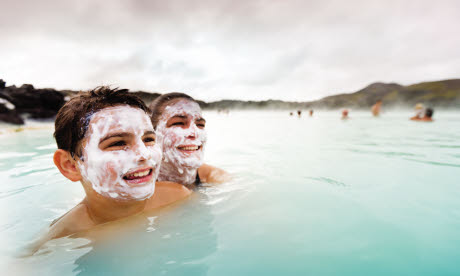
With the autumn weather looming, we highlight the best places to strip off, swim wild and soak up the sun around the world
Perched on the edge of the Victoria Falls in Livingstone, Zambia, Devil's Pool is a natural pool created each year at the fringes of the Falls, when the dry season (Jun-Oct) reduces water levels. Travellers can enjoy amazing views of the mile-wide falls and the somewhat nail-biting 100ft drop to the bottom.
The Ik Kil at Chichen Itza’s Eco-Arqueological Park is a cenote – a deep natural pit which has resulted from the collapse of limestone bedrock and has then exposed the groundwater beneath. Travellers can access the 40-metre deep Ik Kil, which is 26 metres below ground level, via a carved stairway down to a swimming platform.
A surprising find in one of the hottest and driest places in the world. A waterfall located in the Grand Canyon, the Havasu Falls cascade into one large pool. The vivid blue-green colour of the water is caused by the high concentration of calcium carbonate. The area is part of the Havasupai Indian Reservation and is managed by the tribe. Visitors can swim in some pools, although number are restricted and reservations are required.
Otherwise translated as ‘big hole’, To Sua is a 30-metre deep ocean trench, which has been converted into a large swimming pool accessible by ladder. Located in the Lotofaga village, on Upolu island's south coast, the pool is surrounded by lush jungle and greenery. Travellers on a budget should note there is a $15 entrance fee.
Located just south of Luang Prabang, the Kuang Si Falls is a three-tier waterfall, starting on top of a steep hilltop that feeds into shallow pools. The smaller falls and pools lead into one main fall which cascades 60-metres. At the very bottom of the falls there are several blue pools open for swimming and visitors can also enjoy a spot of lunch afterwards on the picnic benches dotted around the park and falls.
Although you won't find sunnier climes in Iceland, the tempting temperatures of Grindavík's Blue Lagoon will keep you cosy. Warm waters average temperatures of 37-39°C and are rich in minerals, which are thought to have healing effects. The lagoon is fed by the water output of the nearby geothermal power plant Svartsengi from a mile below the earth’s surface.
The Hinatuan River is known locally as the ‘Enchanted River’ because the water seems to magically flow without any source. The salt-water river streams from a 50-ft deep spring. Why the spring runs with salt-water is unknown, but the river makes for a quick and easy swim out to the ocean. The cool, blue waters married with the thick, jungly surrounds also make for a very tropical dip.
Pamukkale translates as cotton castle in Turkish and refers to the white castle-like cascades of the Pamukkale Thermal Pools. It is a mountain of mineral baths formed over thousands of years by rich thermal springs. The water, which is thought to have healing properties, contains mainly calcium salts and carbon-dioxide, and ranges in temperature from 36-57°C.
Las Grietas is a canyon formed of two walls which have been created by lava. Both fresh and sea water flow into this pool and temperatures can vary between 18 and 20 ºC – ideal for cooling off. This is the perfect place for a dip, however, not for spotting the region's world-famous wildlife with a snorkel and mask. It also gets crowded from mid-morning onwards: take an early morning dip to make the most of this gorgeous natural pool.
Litchfield National Park is a 1,500-sq-km park found just south of big city Darwin, in Australia's Northern Territory. Bordering most of the Tabletop range – a sandstone plateau surrounded by cliffs – waterfalls cascade and feed into the many pools that are croc-free and ideal for swimming. However, swimmers must check with park rangers before jumping in – pools in Litchfield are more at risk from crocs moving in at short notice.